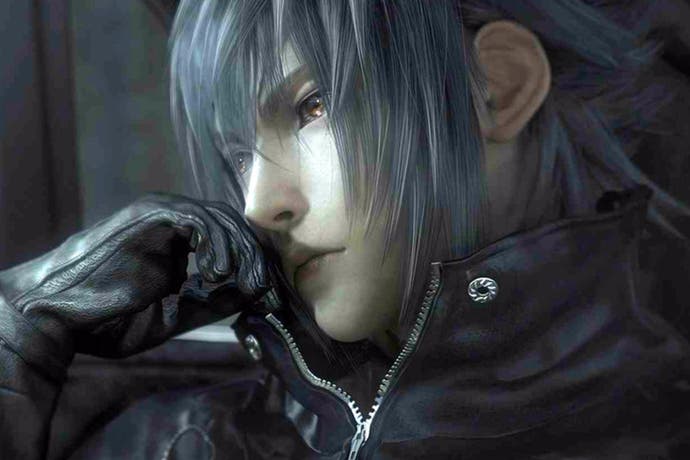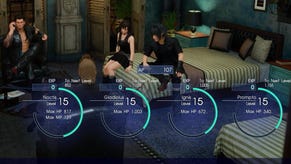Final Fantasy 15 on Xbox One X: improved over Pro but issues persist
The best console version - but extra polish is required.
Since its launch last year, Final Fantasy 15 has changed a lot and Square-Enix has continued to support the game with patches and changes designed to improve the experience for players while introducing features - but this hasn't always gone smoothly. The PS4 Pro has been supported since the game's release and its implementation has always been inconsistent at best. Features have come and gone but in the end, it never seemed to run as well as we would have hoped. Could the new Xbox One X upgrade finally deliver the Final Fantasy 15 experience we've been waiting for?
We were eager to check this one out because the base Xbox One version - as blurry as it is - has a crucial advantage over all PlayStation releases: correct frame-pacing at 30fps, each frame persisting for 33ms, giving a smooth, consistent, gameplay experience. The experience varies across each of the PS4 Pro's rendering modes, but to some extent, all of them deliver frames inconsistently, the impact at its worst in the high quality mode. In effect, bad frame-pacing introduces significant stutter into what is actually a locked 30fps experience.
Well, the results are in and while the upgrade lives up to expectations in many, many ways, there are a number of small issues that do need addressing. As expected, Xbox One X delivers the same three modes as the Pro. High centres on delivering the best quality visuals with a 30fps target, while steady drops back resolution to 1080p and targets the base consoles' visual feature set. Completing the line-up is 'lite', which unlocks the frame-rate. In terms of visual features, both steady and lite modes are much the same between Pro and X - it's the all-important high quality setting that truly sets them apart.
Now, steady was our mode of choice on Pro - it forced us to dial back on bling, but it reduced the bad frame-pacing to a minimum. On Xbox One X, the high quality mode is the place to be. In an interview prior to this update, game director Hajime Tabata suggested that this mode would offer the same resolution as PS4 Pro, using checkerboard rendering. Tabata implied a 3072x1728 resolution but that doesn't appear to be quite the case based on extensive testing we've carried out.
For one thing, based on our pixel counts, Final Fantasy 15 does not appear to operate at a stable resolution - depending on the scene, results can be all over the place. In one shot, while looking at the sky, we got 3360x1890 - an increase over the original claim. If we lower the camera, it drops to 3072x1728 - which is a match for the original quote - but elsewhere, we can shift that resolution downwards to 1584p, 1440p or even 1360p. We ran the same tests on PlayStation 4 Pro and found something very similar. Dynamic resolution scaling is in effect here, with very similar pixel counts to Xbox One X. In fact, occasionally, resolution can even be a touch higher on the Pro.
The key difference here is that Sony's super-charged PlayStation 4 is using checkerboard rendering while - again, contrary to Tabata's quote - Xbox One X delivers native resolution. The presentation is far, far clearer than the Pro and there are no discernible checkerboard artefacts anywhere in the presentation, any softness seeming to derive from the temporal anti-aliasing solution.
So, basically, while the pixel counts are essentially the same, the Xbox One X game is much cleaner. This extends to other details like texture filtering, which is increased slightly on Xbox One X, enabling sharper texture detail throughout the world. Shadow quality also receives a nice bump with distant shadows exhibiting more detail on Xbox One X at a greater distance. It's an impressive jump.
That's not to say image quality is great, mind you. Once you start moving, the lower quality temporal anti-aliasing and motion blur work together to introduce plenty of pixilation into the image. Overall though, from our perspective, Xbox One X offers the better experience - high mode suffers from no frame-pacing issues at all, the visual feature set is tweaked for the better, and there are no checkerboard side effects to contend with. One area that doesn't impress is the UI - it's of 1080p standard, and upscales poorly on the 4K mode.
In terms of performance, Final Fantasy 15 with high mode engaged on Xbox One X starts out strongly. After the first couple of hours, we were extremely impressed. The image quality is excellent in comparison to the Pro, the frame-rate very steady and yes, the game really is completely free of frame-pacing issues, and that's perhaps the biggest improvement of all. However, the about five to six hours into the game, we started to encounter two types of performance issue the compromised the experience to varying extents.












The first one centres on actual performance drops in key areas. The first major city you visit is a good example. This is a gorgeous environment and on Xbox One X, the frame-rate does not hold steady while walking around its central area - something that is less of an issue for the PlayStation 4 Pro version. As a one-off, it sticks out, but it's not really a problem.
However, these drops can pop up during normal gameplay as well in intense areas where heavy environmental features and a lot of enemies can combine to really tank the frame-rate - we managed to reduce FF15 to 20fps or even lower at points. This doesn't seem right at all. Of course, once you finish the battle, it clears right up. These same scenes play out without issue on PlayStation 4 Pro. This isn't common enough to overly compromise the game - in fact, it's relatively fleeting bearing in mind the colossal play-time of the experience - but it's not what you expect from the Xbox One X. It feels like there is more work to be done.
The second performance issue manifests when playing the game for a long time, and may be related to using the console's sleep mode. We noted frame-rate drops to the low 20s even in relatively light areas, never recovering back to the target 30fps. It was severe enough to make us pause, save the game and restart, which completely solved the issue. Needless to say, this is rather strange and we hope that Square-Enix takes some time to look into both of these issues - sorting them would add the final layer of polish to what is otherwise a superb port.
We should also mention the lite mode, which unlocks frame-rates and runs at a maximum 60fps. It runs in a very similar manner to the Pro version, spending most of the duration in the 30-40fps area with a locked 1080p resolution. The truth is that due to the added judder incurred by the uneven frame persistence, it winds up looking choppier than the 30fps options. Plus, on Xbox One X, this mode introduces tearing, compromising image integrity. It's nice that the option is there for those that like it and maybe it could prove useful for a next-gen Xbox in back-compat mode, but for now, we can't recommend it.
Bearing in mind how smooth the high mode is for the vast majority of gameplay, the 1080p30 steady mode seems to a touch superfluous. Yes, it irons out those infrequent performance drops we can incur with high quality visuals selected, but even in this mode we can cause mild frame-rate dips, which does not seem right at all. The PS4 Pro does not struggle in similar situations, suggesting that it's not a CPU limitation we're looking at. It just feels like the X patch isn't as well optimised as it could be.
By and large though, high mode on Xbox One X is the best way to play Final Fantasy 15 on consoles - you get a more refined version of the PS4 Pro game, without its frame-pacing judder. However, there's still the sense that Square could do more to allow FF15 to sit more comfortably on Xbox hardware. For example, the game assigns the lock-on button to the right or left bumper. These buttons work fine as simple buttons presses but FF15 asks you to hold the button during combat at almost all times and it's just not comfortable.
So what can you do? Well, unfortunately, the standard Xbox One pad does not allow you to re-map triggers - swapping the right bumper and right trigger would solve the problem, since the standard right trigger function is used far less. If you have an Xbox One Elite controller, however, it is possible to make this switch. However, adding a button remapping feature surely isn't too much to ask for?
The sense is that Final Fantasy 15 has its share of inconsistencies and frustrations on all platforms, with each version possessing its own share of problems that combine to detract from the overall experience. Ultimately though, we have to hand it to the Xbox One X port as the best way to play the game - while the performance issues and potential sleep mode bugs are annoying when they manifest, it's still the best-looking version on consoles with mostly stable performance overall... provided you start it from a fresh boot. It's just a couple of steps away from being a brilliant experience, it just needs a little more polish to get it to where it needs to be.
You can support Digital Foundry's work and gain access to our entire archive of 1080p and 4K video by backing us on Patreon for just $5 a month.


















